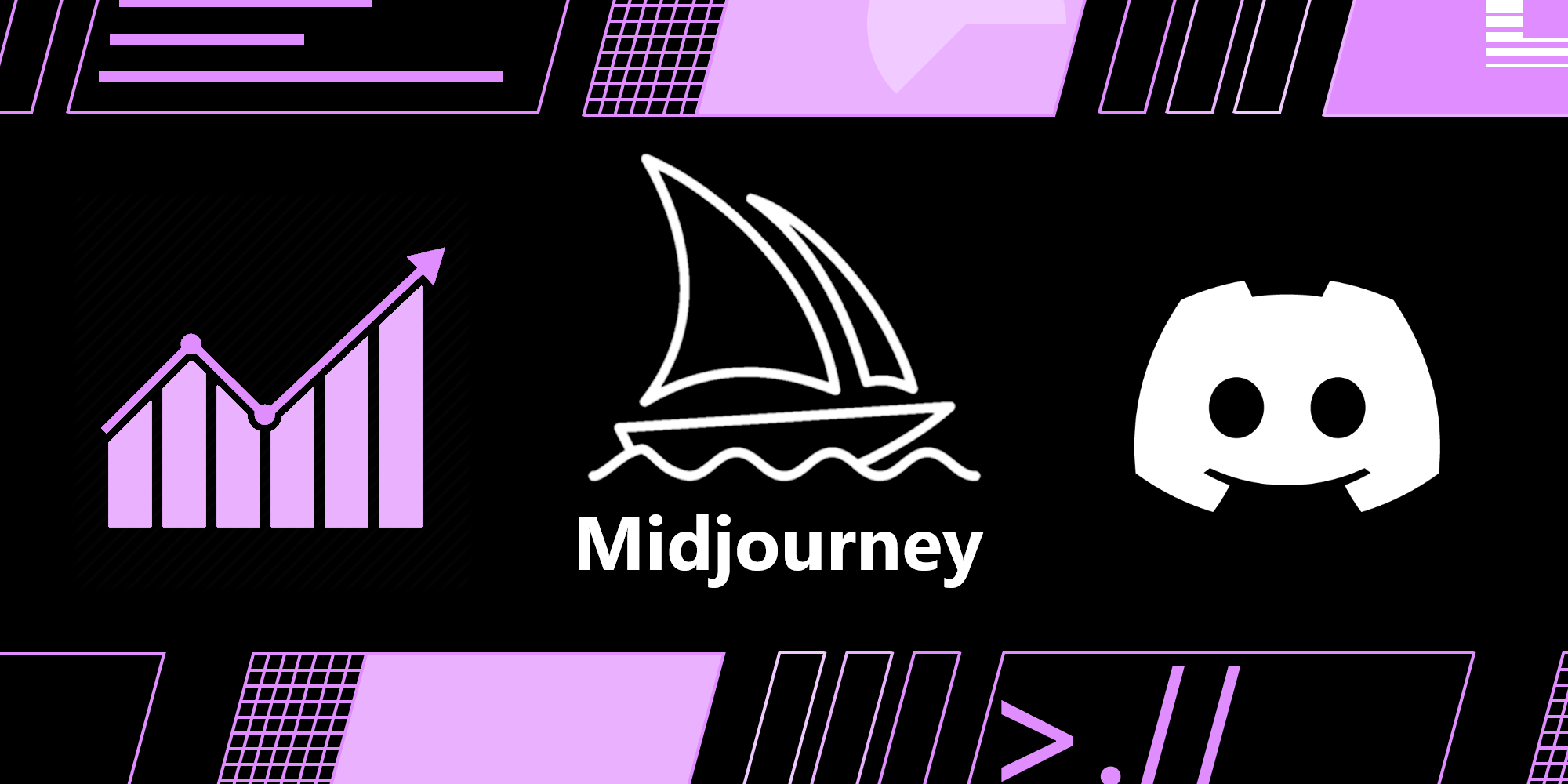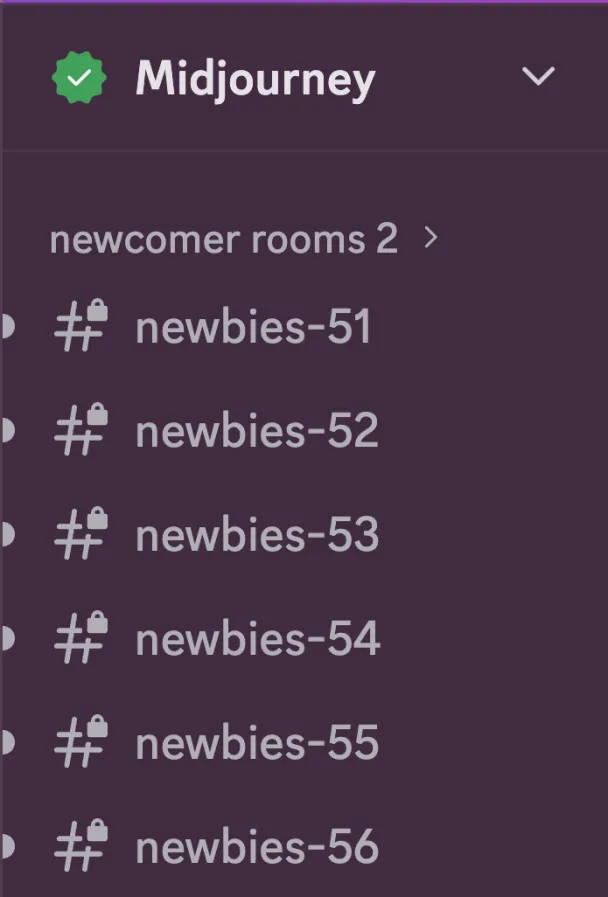How Midjourney Conquered Discord
The Midjourney Discord server sits at >20 million members. How did it get here? Where is it going next?

Midjourney is easily one of the largest apps running on Discord, with it's community featured prominently in Discord's server discovery page. With over 20 million members, it's the single largest server on the entire platform.

But how did Midjourney get here? How does it handle millions of users?
I reached out to a member of the Midjourney team to interview them, which we'll cover in this article!
Generative AI can be a very polarizing topic. We've previously discussed Discord's own AI experiments on this blog. The focus of this article will not be AI technology, but rather Midjourney's adoption of Discord, its community & its growth.
Why choose Discord as the launch platform for Midjourney?
Very early on we had a prototype of image generation working through [our] website (and maybe even email, not 100% sure) and discord. When we showed the tool to new/potential users, a very common interaction on a website went like "hey type in anything", and the user goes in and types "dog", and then get an image of a dog. After that they were like "oh okay that's cool" but didn't really know where to go from there.
Discord made a huge difference, if you ask for an image of a dog in a public channel, someone else can see what you did and do something like /imagine dog in a park, then next person goes /imagine dog in a park chasing a ball etc etc and it turns into a full fun social interaction. The website felt isolating, alone, you don't know what you are doing, while Discord suddenly turned it into a creative collaborative interaction.
This was the main factor why we released the first version on Discord, and only implemented creation on our website later on once the product was more mature and had a solid Discord userbase.
This, I believe, underpins much of Midjourney's success. Creating an innately social experience by operating on social media has allowed them to directly meet their users where they already are - something many companies strive to do.
What measures do you take to scale up the Midjourney community on Discord, how do you handle moderation & support?
We have an amazing community of "guides" and "moderators" and had a great team for a long time. Guides are people from the community knowledgeable about the bot that they can hang around various channels on discord, help new users with the bot/prompting interface. Moderators are senior guides with more permissions to be able to handle disruptive users.
As we scaled up, we built a dedicated support team, where some of the people on the team were previously guides/moderators, and some employees were hired externally.
Regarding moderation of the server, people who are not subscribed to Midjourney have very little permissions, which makes moderation considerably easier. Users who are not subscribed only have chatting access to the "newbie" channels that are dedicated for generation, so it is very hard to be disruptive. Of course it does happen, trolls, disruptive and/or hateful users still join and ping team members/moderators in these channels but they are rarely disruptive to regular members. People who are subscribed tend to be way nicer - they like the product that they pay for and usually engage in a friendly and constructive way, and moderating that is suddenly way easier and manageable by our moderator team, even though the server has almost 21 million members.
Moderation is a challenge for communities of all sizes, however the structure of Midjourney's server has lended it well to moderation, and allowed them to continue to scale without many of the challenges other communities have faced. Discord recently released an article about setting up server permissions, an ounce of prevention is worth a pound of cure and this is especially true for moderation.
How does Midjourney scale to handle interactions from millions of users via the Midjourney Discord bot?
We mostly use HTTP interactions. We do also listen for reactions on the ❌ and 📩 emojis for different functionality for easier access, but that does not work with user apps, and 99% of the traffic are interactions anyway. We have a (rust) gateway/interactions proxy that we never restart and it only forwards the events to our internal infrastructure. On the other end, we make requests through the twilight http proxy (modified a bit but the core is the same) to manage ratelimits. Thankfully rust is fast and these singular points can handle all the traffic with not much difficulty.
HTTP Interactions were introduced in 2020, and allow Discord apps (bots) to receive data from Discord via HTTP webhooks, instead of via the Discord Websocket Gateway. This approach allows web-based workers (Such as Cloudflare Workers, AWS Lambdas & Google Cloud Run Workers), which allows for much more scalability. The Discord Gateway, while scaleable, relies on resource-intensive always-alive Websockets to receive data. As Midjourney is only leveraging this for one intent (Reactions) the volume of data they receive over this Websocket will be low, and thus easier to scale.
How has Discord supported your operation on their platform?
When we initially launched Midjourney, the biggest server on Discord had 1 million members. Discord helped us scale beyond this limit and the server is now at almost 21 million members (at the time of writing). Of course with this size come[s] many technical and practical challenges, and there were definitely growth pains but we are in a good spot now.
For example, we have many "newbie" channels numbered from 1 to 200, and when a member joins they get assigned a role that unlocks access to 2 of these channels. Early on this meant the traffic each users client received was way lower compared to if each user had access to all channels. Fun fact about this, users were joining at a rate higher than was the ratelimit of "add role to member" endpoint, so we had to make several bots dedicated to assigning roles on the midjourney server to get around the ratelimit.
Leveraging different channels is an incredibly smart way to scale a Discord server. This achieves several goals:
- Limiting the message events members see
- Reducing stress on Discord's infrastructure (allowing higher member limits)
- Improving ease of moderation by limiting message throughput

Additionally, Midjourney was previously listed on the front page of the Discord App Directory with the 'PARTNER' tag, something that has no other App has ever received. The nature of this partnership is not explicitly known, but as Midjourney has brought many new signups to Discord's platform, it's greatly beneficial for both companies to have a close working relationship.

Midjourney now has its own platform, is Discord still a core part of your roadmap?
Absolutely, Discord is very important to us, [a] significant portion of our userbase uses discord and the discord server is a great place to centralize our community. We host regular events, such as open office hours hosted by the CEO where he talks about stuff and answers questions. We also use it to announce new features, gather feedback from the community etc.
Is Midjourney exploring the activities SDK?
We experimented with it, and while it is a great tool we do not really have a use for it.
Components V2 has radically changed how many Discord applications display their UI, is this something Midjourney is adopting?
Components V2 are great, but we do not really have a reason to switch to them. Our product is quite simple, most of the time you have 4 images in a grid with buttons under them, there is not much that interface benefits from with components V2. However if a smaller command/feature comes across that would benefit from features components V2 provides, we will definitely look into using them.
What hopes do you have for Midjourney over the next year?
We just had out biggest release in a long time - video generation. Video generation is hard, it is hard to get good quality, and make it affordable at the same time, and I think we struck a good balance there. However it can be always improved upon and this will likely be our focus for the foreseeable future, as we develop the building blocks towards real-time open-world simulations.
Conclusion
So, how did Midjourney scale so large, so fast, with such stability? From this interview, and from my own research, the answer seems threefold.
Meeting the users where they are
Sure, you can go to tens - even hundreds - of websites to interact with AI. But you're already using Discord, so why move to those other platforms when you can just use a slash command on the site you're already on? Why hand over your email & make an account on other services when you can just join a Discord server & use your Discord account with OAuth2?
Community first
Midjourney, from the beginning, was built to be in and for communities. You don't need to show your friends something you did with their app if they're in the same channel, seeing the result at the same time as you. Most companies struggle with getting users to share content outside of their websites & apps, Midjourney does it by nature.
Working with the platform
Midjourney is mutually benifical with Discord, and has collaborated with the platform to scale their community to numbers that would never even be imaginable for the company when it was made in 2015. Keeping this working relationship has allowed Midjourney - and Discord - to thrive.
Want to read more about this topic? Discord has their own Case Study on Midjourney. Give it a read!
This article is part of a new series, covering various success stories on Discord. In future we hope to cover bot/server listing sites, communities, bots and more!
